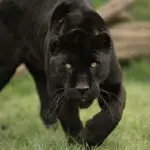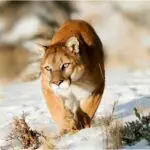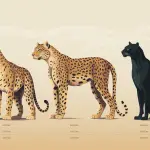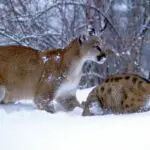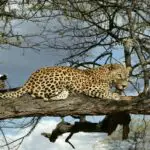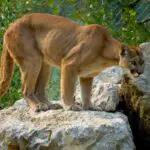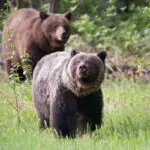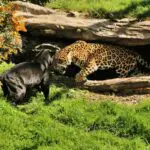Want to find out about the differences between the jaguar and the mountain lion?
Although both are large types of cats, there are many differences between them. The most noticeable is their appearance, though.
Jaguars are golden with large black rosettes, while mountain lions are a tawny brown.
The jaguar is also typically much larger than mountain lions, and has a more muscular frame and stronger bite force.
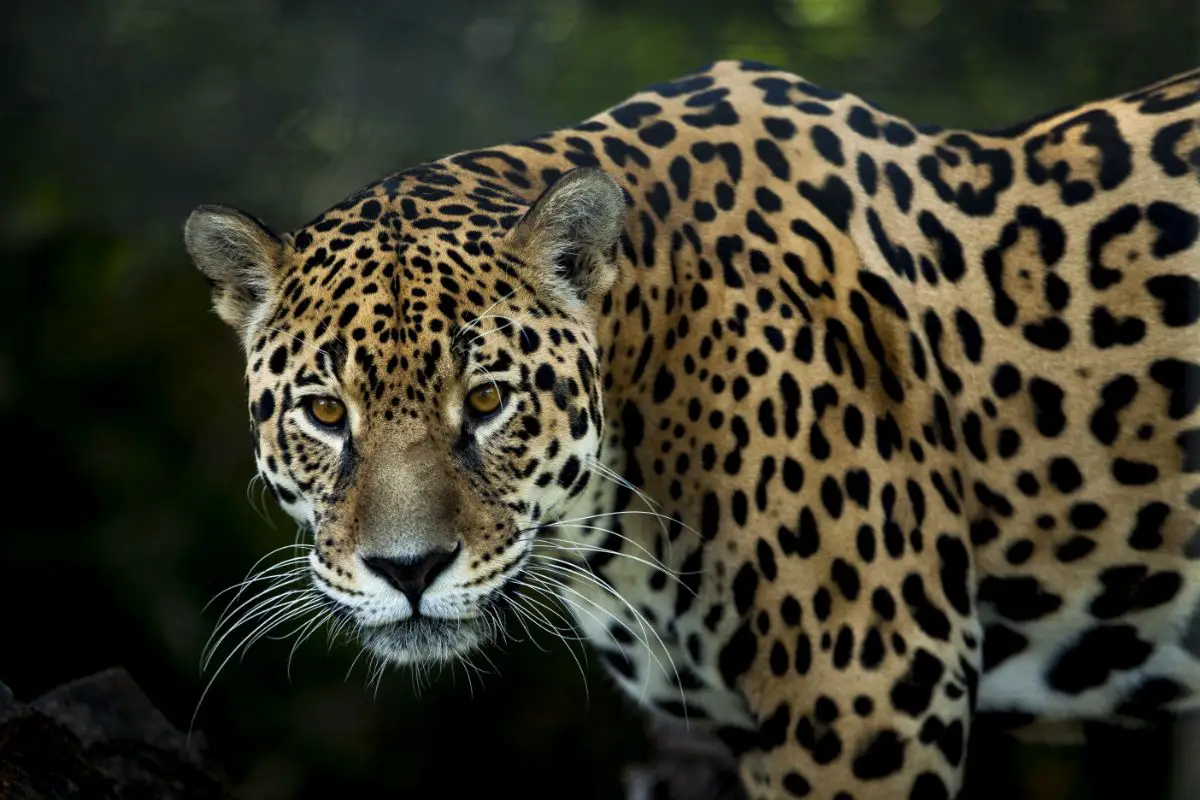
Mountain lions have six subspecies, and one extinct one. These animals have the world record for an animal with the most English names, too!
The jaguar, on the other hand, typically only goes by one – jaguar.
This is thought to come from the word “yaguareté”, which means “true, fierce beast”, as this animal is a symbol of power and strength.
The name also comes from the word “yaguar”, which means “he who kills with one leap” – a fitting name!
If you want to find out about all the other differences between these majestic animals, keep reading!
We will go through everything you need to know in this article.
Mountain Lion Vs Jaguar: The Main Differences
Classification
Jaguar
- Also Known As: jaguar
- Average Lifespan In The Wild: 12-15 years
- Scientific Name: panthera onca
- Genus: Panthera
- Family: Felidae
- Order: Carnivora
- Class: Mammalia
- Kingdom: Animalia
- Phylum: Chordata
- Height: 2-3 feet at the shoulder
- Weight: 220-350 lbs
- Length: 5-7 feet (head and body); 2-3 feet (tail)
- Conservation Status: varies depending on subspecies, typically near threatened
- Number Of Subspecies: 9
Mountain lion
- Also Known As: puma, cougar, panther, catamount, red tiger, deer tiger, painter
- Average Lifespan In The Wild: 10-13 years
- Scientific Name: puma concolor
- Genus: mountain lion
- Family: Felidae
- Order: Carnivora
- Class: Mammalia
- Kingdom: Animalia
- Phylum: Chordata
- Height: 2-3 feet at the shoulder
- Weight: 64-220 lbs
- Length: 3.25-5.25 feet (head and body); 23.5-33.5 inches (tail)
- Conservation Status: varies depending on subspecies, typically least concern (population decreasing)
- Number Of Subspecies: 7 living subspecies, one extinct
Appearance And Characteristics
Jaguar
Jaguars are the largest cats in the Western Hemisphere, and the third-largest cat species in the world, after the lion.
They can reach lengths of 5-7 feet from their note to the base of their tail, and the tail can be a further 2-3 feet.
In total, they can reach lengths of 9-10 feet, a very impressive size!
These animals typically weigh between 220-350 lbs and can be three feet at the shoulder.
They are bulkier than other cats like mountain lions, and have rounded faces.
The jaguar has one of the most notable coats in nature. It has a beautiful yellow-tan coat with black rosettes.
The shade of the base color may vary depending on where the animal is located, as jaguars in thick rainforests typically have a more golden color.
Rosettes of jaguars are like jagged black circles with dots of black inside them.
These animals are stockier compared to most other large cats, and are noticeably more bulky than the lean mountain lion.
Like most cats, the jaguar has black markings on the back of their ears, and black markings around the muzzle and eyes.
Jaguar cubs look similar to their parents and have the same yellow-brown fur with rosettes.
However, cubs are born with blue eyes. As the cub gets older, their eyes color will change to the golden or red-yellow that adults have.
Mountain Lion
The mountain lion is a large, tan cat with a white or gray belly and chest.
Their color can vary slightly depending on where in the Americas they are.
However, they will always be a shade of tan or a tawny brown unless they have a mutation.
Some mutations can cause animals, including mountain lions, to be black, white, or mixed variation.
Besides their recognizable tawny coloring, a mountain lion will also have a few black markings.
These markings will be around the animal’s snout, the tips of their ears, and the tip of their tail.
Adults have eyes that can appear to be a green-brown or yellow color.
This coloring will eventually appear when a mountain lion is about a year and a half old.
Mountain lion cubs have a very different appearance from their parents.
They are covered in black spots to help them blend into their surroundings, but have the same tan or tawny colored fur as their parents.
Compared to adult mountain lions, the young have more black on them.
This black is visible on their faces, including their snout and above their eyes. Cubs also have blue eyes that change color as they get older.
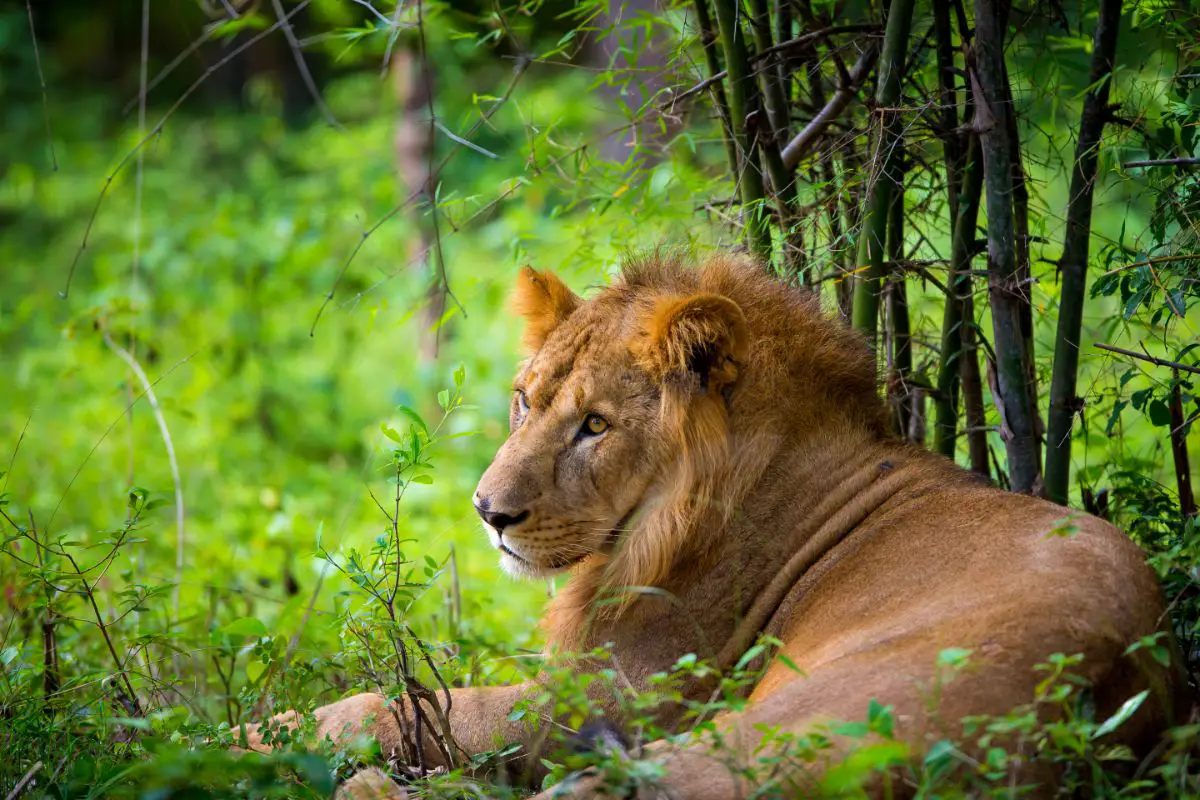
Typically, the larger animals are closer to the poles and will be in counties like Alaska and Argentina or Chile.
Closer to the equator, in countries like Colombia, Ecuador, and Brazil, mountain lions are usually smaller.
These animals typically only reach lengths of around 5 feet, and their tails are between 23 and 33 inches long.
So, from nose to the tip of the tail, a mountain lion can measure up to 7.7 feet long.
Up to the shoulder, mountain lions can measure up to a maximum of three feet, and they can weigh up to 220 lbs.
It should be said that the majority of mountain lions will be slightly smaller, as these numbers are on the upper limit.
Female mountain lions are also smaller than the males. The females are more likely to weigh up to 120 lbs, and are generally about ⅓ smaller than the males.
Sounds And Calls
Jaguar
Jaguars cannot purr like mountain lions and house cats. However, they are known to be very vocal animals, and will grunt, mew, and roar.
The most notable sound these animals make is referred to as “sawing”. This is because it sounds exactly like wood being sawed in half (moving in one direction).
When jaguars greet each other, they will also make a nasally snuffling noise.
This sound is thought to also be made to reassure other jaguars.
If a jaguar is happy, they may start “chuffing”, which is similar to purring, but it has a very low intensity, and only happens in loud, short bursts.
Mountain Lion
Mountain lions can make a range of sounds, but they can’t roar like lions or tigers.
A mountain lion will growl and hiss, like a house cat, and they can also purr.
Males and females are known for their “scream” that can often be heard in the wilderness.
This scream is loud and shrill, and resembles a woman’s scream very closely. In fact, the two are often mistaken for each other.
This scream is the most well-known sound of a mountain lion.
This sound is something that you should always look out for if you are out.
For female mountain lions, this scream is thought to indicate that they are ready to mate and is done to signal that to males in the area.
If you hear something that sounds like a screaming woman in the wild, you should move in the opposite direction.
Mountain lion cubs can hiss and make chirping sounds. This chirping is thought to be a way of them locating their mother, and the mother will chirp back.
Family
Jaguar
The jaguar is part of the Felidae family, so it is a cat.
Mountain Lion
The mountain lion is part of the Felidae family, meaning that it is also a cat.
Mountains And Range
Jaguar
Jaguars are found only in Central and South America, with a few exceptions in the southernmost states of the United States.
They primarily live in rainforests like the Amazon, or wetlands like the Pantanal.
These animals also do well in arid scrubland, grasslands, tropical forests and rainforests, mangroves, swamps, mixed conifer forests, and lowland river valleys.
As such, they are good at adapting to new surroundings, which is why they have managed to survive in Arizona!
Historically, there used to be jaguars in a number of US states, including New Mexico, Louisiana, and even eastern Texas.
Now, however, they are only found in southern Arizona, where they live only in small numbers.
Jaguars are known for their excellent swimming abilities, which has helped them survive in wetlands and rainforests, occasionally feeding on alligators.
Mountain Lion
Mountain lions cover an extreme range – all the way from Alaska to Argentina and even southern Chile.
Because of this, they can thrive in a variety of ecosystems as long as there is prey and shelter at their disposal.
It would not be unusual to see mountain lions anywhere from mountainous regions to deserts, forests, and wetlands.
They are very adaptable and do well in many ecosystems as long as there is food and shelter.
No matter where they are, mountain lions typically prefer to stay away from humans and too much development.
There have been instances, however, where mountain lions are seen close to cities, or in city suburbs.
Social Behavior
Jaguar
Jaguars are solitary animals for the majority of their lives. The only time they are not alone is during the mating season and when females are raising their cubs.
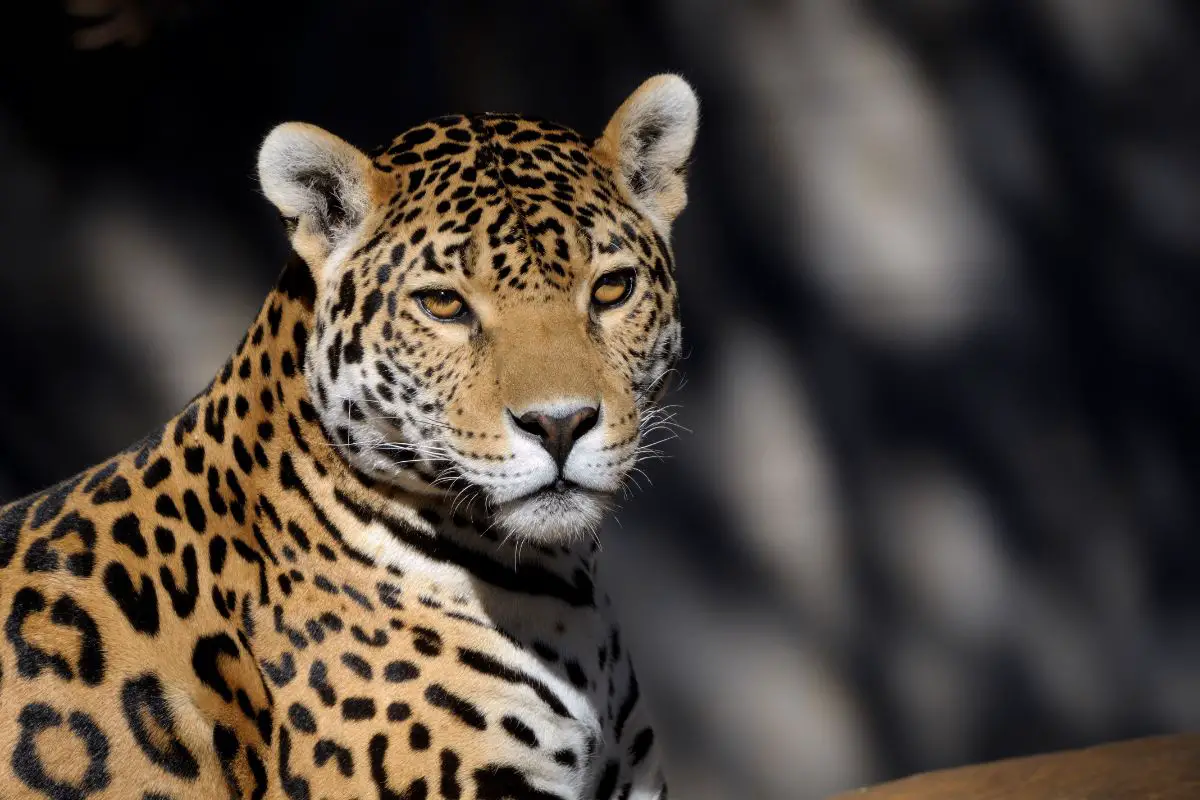
These animals typically only need between 10-50 square miles of territory in order to be happy.
However, territory sizes vary depending on where the animal is located.
Mountain Lion
Mountain lions are also solitary animals. This means that they live alone and have their own territories.
The only time that these animals don’t live alone is during the mating season and when the female is caring for her cubs.
When solitary, these animals need between 50 and 125 square miles to roam, with males preferring more space.
Diet
Jaguar
Like mountain lions and all other cats, jaguars are obligate carnivores.
This means that they can only get the nutrients they need from meat rather than vegetation.
This does not mean that they cannot eat other food types, but simply that they would not get the benefit of doing so except for the flavor.
Jaguars will eat anything from tortoises to deer, capybara, armadillos, monkeys, fish, birds, and even the occasional alligator.
They will also prey on tapir, though they typically prefer to stick to smaller animals.
Mountain Lion
Mountain lions are obligate carnivores, like all other cats. They will typically hunt for things like deer or sheep, but will also eat smaller animals like mice and rabbits when available.
Breeding
Jaguar
Jaguars don’t have a set time of year for mating. They can mate at any time of the year, and they have a gestation period of only 100 days.
The females will give birth to a litter between 2-4 cubs, which will stay with her until they are at least a year old.
At this point, the cubs will no longer be fed by her, but they will remain with her for another year.
Jaguars will only reproduce every two years once they reach sexual maturity.
These animals reach sexual maturity when they are 3-4 years old.
Mountain Lion
Mountain lions also don’t have a set breeding or mating season. Mating can happen at any time of year.
However, the majority of mountain lion births take place in the late winter or early spring, but this is not always the case. Females will reproduce every two years.
These animals have a gestation period of 90 to 96 days. When the mother is ready, she will typically give birth to between 1-5 cubs.
These cubs will then stay with her until they are ready to live on their own.
This is usually until they are around 15 months, or little over a year old.
However, some cubs will stay with their mother until they are over two years old before venturing off on their own and start reproducing themselves.
Who Would Win In A Fight?
Depending on where these animals cross paths, the outcome could be different!
If a smaller jaguar (like those in Arizona), came across a mountain lion that was larger, the fight might end in a draw.
However, as jaguars are typically much larger and more powerful (and with a much stronger bite force), we can guess that the jaguar would come out on top.
Final Thoughts
The biggest difference between the jaguar and the mountain lion is their appearance, specifically the coat.
Mountain lions have no distinguishable markings, and have only a tawny or tan colored coat.
Jaguars, on the other hand, are incredibly striking and recognizable.
So, although both the jaguar and mountain lion are cats, there are remarkable differences between them.
- Bengal Cat vs Wild Bengal Tiger: Complete Comparison 2025 - October 31, 2025
- Complete Wild Cat Spotting Guide for Hikers 2025 - October 31, 2025
- Lynx vs Bobcat: Complete Field Identification Guide 2025 - October 30, 2025

